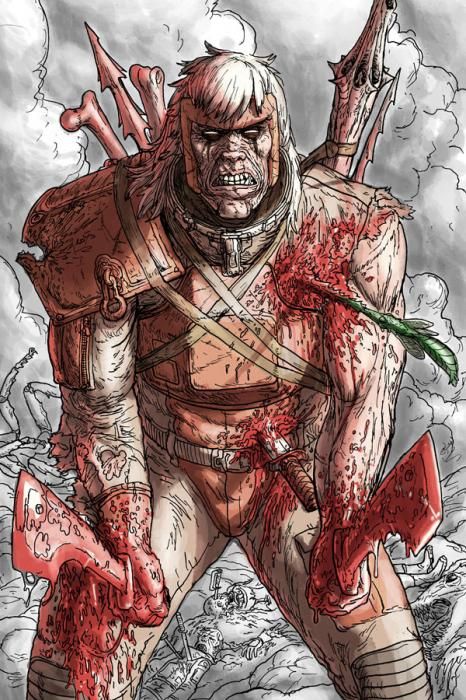If world-building was a Comics Olympic sport, Brandon Graham, Giannis Milonogiannis and Simon Roy would be frontrunners for the intricacy, vastness and sheer pace of their universe construction in "Prophet." Many other comics have been set in outer space, but like issues #21-27, "Prophet" #28 is consistently challenging to the mind and eye. Before readers can follow the thread of the tale, they must adjust to the unusual third-person point of view, the text-heavy, stream-of-consciousness narration and the truly alien quality of the images and the series itself. "Prophet" breaks all kinds of comics storytelling conventions, yet it works on its own terms. From a reader, it requires the readiness of a world traveler for new sights and the patience to continue looking until new knowledge is absorbed.
Milonogiannis' surreal alien landscapes and well-balanced compositions in "Prophet" #28 ground the reader in concrete visuals, but at the same time his images are confoundingly fantastical and consistently startling. Nothing but John Prophet himself looks familiar to the eye. Milonogiannis has a seemingly endless visual imagination. The striated lines he uses on the opening page to indicate light-speed are gorgeous, and in another memorable panel, he creates mood through scale as Prophet and Brother Hiyonhoiagn walk down a tunnel-like hallway punctuated evenly with high arched windows of open sky.
Colorists Joseph Bergin III and Charo Solis' palette in "Prophet" #28 is mixture of equal parts warm neutrals and saturated bright hues like periwinkle blue, mint green and persimmon orange. These unusual, lush colors, laid down flat within Milonogiannis' lines, are a balm to the eyes. I particularly enjoy how Bergin and Solis use complementary colors for the written sound effect onomatopoeia words, with "KPSHH" popping in eggplant-violet behind Prophet over a lemon yellow background, or the brick red "KRAKL" behind Diehard as he releases "stored crystal energy" into a muddy turquoise space. Their approach to shading also speaks to their exceptional skill and familiarity with color theory and painting technique. In one panel, half of Prophet's body is light teal-colored, while the unshadowed side is reddish beige. It sounds wrong, but it looks amazing, defining shadows and shape far more beautifully than a digital gradation of one color.
The writing, too, demands that the reader slows down, and the underlying story always emerges cleanly after the culture shock wears off. Diehard, formerly of "Youngblood," is the unexpected driving force for the plot of "Prophet" #28. His need propels this weird pilgrimage by Old Man Prophet and his friend Brother Hiyonhoiagn, who are helping their old friend by carrying around his almost-intact body that is seeking to reunite itself with its head. While this story is seemingly about friendship and quest, it has neither the relationship development of a character story, nor the suspense or shape of a quest. Eight issues into the relaunch, John Prophet is still a legend and cipher, not a living and breathing man with whom the reader can identify. "Prophet" #28 evokes wonder, not suspense. This lack of character development and plot tension isn't necessarily a defect, however, but a byproduct of intentional style.
First and last, "Prophet" is about landscape and history, about a longer epic journey within worlds that are old to John Prophet but new to the reader. The creative team's aesthetic choices make "Prophet" very still, very quiet. A lot of the comic is taken up by text boxes with enigmatic, poetic prose that requires the concentration and listening that poetry usually does. Despite all the action scenes, "Prophet" is not an action book -- it's a story in which action occurs like ripples on the surface of a lake, stretching soundlessly to fill the horizon.

